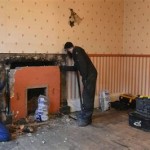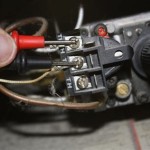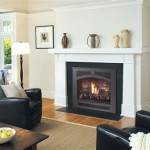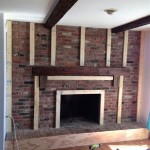Selecting and Applying Paint for the Interior of a Wood-Burning Fireplace
The interior of a wood-burning fireplace is subjected to extreme conditions. High temperatures, soot accumulation, and creosote buildup pose significant challenges to any coating applied to its surface. Choosing the appropriate paint and applying it correctly are crucial for achieving a lasting and aesthetically pleasing finish that can withstand these harsh elements. This article will explore the specific requirements for paint used inside a wood-burning fireplace, the types of paint suitable for this application, and the necessary preparation and application techniques.
The primary function of paint in a fireplace interior is to improve its appearance. A clean, well-painted firebox can brighten the space and enhance the ambiance of a room. However, aesthetics are secondary to the paint's ability to withstand the extreme heat and prevent corrosion of the firebox material. A poorly chosen paint can blister, peel, crack, and release harmful fumes, creating both an eyesore and a potential safety hazard.
Understanding the Requirements for Fireplace Paint
Paint intended for use within a wood-burning fireplace must possess specific properties to perform effectively and safely. These properties are not generally found in standard interior or exterior paints.
Heat Resistance: The most critical requirement is the paint's ability to withstand high temperatures. Fireplace paints must be heat-resistant to temperatures exceeding 1200°F (649°C) or higher, depending on the expected intensity of the fire. This high heat resistance prevents the paint from breaking down and releasing potentially toxic fumes when exposed to flames.
Durability: Fireplace paint should be durable enough to resist chipping, cracking, and peeling under extreme temperature fluctuations. Rapid heating and cooling cycles can cause significant stress on the paint film, leading to premature failure if the paint is not formulated to handle these changes.
Adhesion: Proper adhesion to the firebox material, typically brick, refractory panels, or steel, is essential for long-term performance. The paint must be able to bond strongly to the surface, even when it expands and contracts with temperature changes. Surface preparation plays a crucial role in ensuring proper adhesion.
Low VOC Content: Volatile Organic Compounds (VOCs) are emitted as the paint dries and can be harmful to human health. Fireplace paints should have low or zero VOC content, especially when used in enclosed spaces. High heat can exacerbate the release of VOCs from paints not designed for fireplace use.
Resistance to Soot and Creosote: Soot and creosote are byproducts of burning wood and can accumulate on the interior surfaces of the fireplace. The paint should be resistant to staining and degradation from these substances, enabling easy cleaning or requiring infrequent repainting.
Choosing the Right Type of Paint
Several types of paint are formulated for high-temperature applications, but only a few are suitable for the specific conditions inside a wood-burning fireplace. Understanding the characteristics of each type helps in making an informed decision.
High-Temperature Aerosol Paints: These are typically silicone-based paints designed for use on stoves, engine blocks, and other high-heat equipment. They are easy to apply and offer good heat resistance, typically up to 1200°F. They are available in various colors, including black, which is the most common choice for fireplace interiors. Aerosol paints are best suited for smaller areas and touch-ups.
Refractory Paints: Refractory paints are specifically designed for use in furnaces, kilns, and other high-temperature industrial applications. They offer excellent heat resistance and durability and are often used on firebricks and refractory panels. These paints are typically available in liquid form and require application with a brush or sprayer. Due to their industrial nature, ensure the specific product details include suitability for residential fireplaces.
Fireplace Paint Kits: These kits often include a cleaner, primer, and topcoat specifically formulated for fireplace interiors. They provide a complete solution for preparing and painting the firebox, offering convenience and ensuring compatibility between the different products.
Important Considerations: Avoid using standard latex, acrylic, or oil-based paints inside a wood-burning fireplace. These paints are not designed to withstand high temperatures and will likely fail quickly, releasing harmful fumes in the process. Even high-temperature paints intended for barbecues or grills may not be suitable, as they may not be formulated for the enclosed environment of a fireplace.
Preparation and Application Techniques
Proper preparation and application are just as important as choosing the right type of paint. Thorough preparation ensures proper adhesion and a long-lasting finish, while correct application techniques contribute to a uniform and aesthetically pleasing appearance.
Safety Precautions: Before starting any work, ensure the fireplace is completely cool and the area is well-ventilated. Wear appropriate safety gear, including gloves, eye protection, and a respirator, especially when working with aerosol paints or cleaning agents. Protect surrounding surfaces with drop cloths or plastic sheeting to prevent overspray or spills.
Cleaning the Firebox: The first step is to thoroughly clean the interior of the fireplace. Remove all loose soot, ash, and debris with a wire brush or vacuum cleaner. For stubborn soot or creosote buildup, use a specialized fireplace cleaner or a solution of trisodium phosphate (TSP) and water. Follow the manufacturer's instructions carefully when using any cleaning product. Rinse the surface thoroughly with clean water and allow it to dry completely before proceeding.
Repairing Damaged Surfaces: Inspect the firebox for cracks, chips, or other damage. Repair any significant damage with refractory mortar or patching compound following the manufacturer's instructions. Allow the repair material to cure completely before painting. Small cracks may not require repair prior to painting.
Priming (Optional): In some cases, a high-temperature primer may be recommended to improve adhesion, especially on porous surfaces like brick. Follow the manufacturer's instructions for applying the primer and allow it to dry completely before applying the topcoat. Some paint products are self-priming and do not require a separate primer application.
Applying the Paint: Apply the paint in thin, even coats, following the manufacturer's instructions. Avoid applying too much paint at once, as this can lead to drips, runs, and poor adhesion. Use a brush, roller, or sprayer, depending on the type of paint and the size of the firebox. Allow each coat to dry completely before applying the next coat. Typically, two or three coats are sufficient to achieve full coverage and a durable finish.
Curing the Paint: After applying the final coat, allow the paint to cure completely before using the fireplace. The manufacturer's instructions will specify the recommended curing time, which can range from several hours to several days. Curing allows the paint to fully harden and develop its heat-resistant properties. During the curing process, avoid exposing the painted surface to moisture or extreme temperatures.
Ventilation: If possible, keep the room well-ventilated during the painting and curing process. Open windows and doors to allow fresh air to circulate and help dissipate any fumes. Consider using a fan to improve ventilation.
Disposal: Dispose of all used paint cans, brushes, rollers, and cleaning materials properly, following local regulations. Do not pour leftover paint down the drain or into the ground.
Painting the inside of a wood-burning fireplace requires careful planning, proper material selection, and meticulous application techniques. By understanding the specific requirements for fireplace paint and following these guidelines, it is possible to achieve a durable, aesthetically pleasing, and safe finish that will enhance the enjoyment of a fireplace for years to come. Always consult the paint manufacturer's instructions for the most accurate and up-to-date information regarding their specific product.

Painting The Interior Of A Fireplace Shine Your Light

How To Paint Behind A Wood Burner Brewers Know The Decorating Knowledge And Advice You Need

How To Spray Paint Fireplace Interior The Diy Playbook

Paint Inside Of Your Fireplace South House Designs

Can A Fireplace Be Painted We Love Fire

How To Paint Inside A Fireplace An Updated Look Painting

Painting The Interior Of A Fireplace Shine Your Light

Fireplace Safe Paint What You Need To Know Dreifuss Fireplaces

How To Paint A Fireplace Bring It Up Date We Love Fire

Tips For Painting Behind Wood Burners And Fireplace Surrounds








